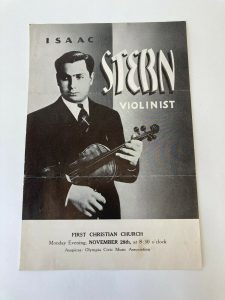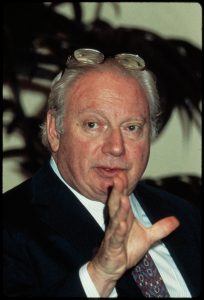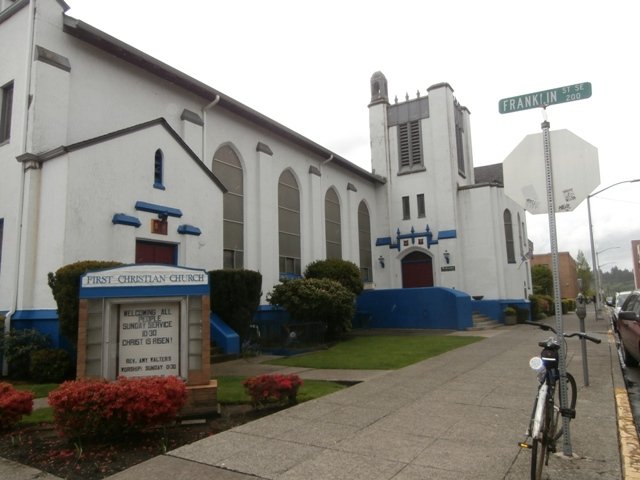 Olympia’s First Christian Church was packed on the evening of November 28, 1938. Audience members had bought their tickets in advance, seeking to support a new program’s efforts to bring world-class musicians to their hometown. This was the first concert. The audience quieted as the young violinist began to play. Although only 18, Isaac Stern had already performed across the country. No one in the audience could have known that he would come to be known as one of the best concert violinists of the 20th century. But the concert was, as the Daily Olympian celebrated later, “one of the finest musical evenings that has been offered around this locality in many a moon.”
Olympia’s First Christian Church was packed on the evening of November 28, 1938. Audience members had bought their tickets in advance, seeking to support a new program’s efforts to bring world-class musicians to their hometown. This was the first concert. The audience quieted as the young violinist began to play. Although only 18, Isaac Stern had already performed across the country. No one in the audience could have known that he would come to be known as one of the best concert violinists of the 20th century. But the concert was, as the Daily Olympian celebrated later, “one of the finest musical evenings that has been offered around this locality in many a moon.”
Stern was born in Krzemieniec, Russia in 1920 (now Kremenets, Ukraine) to a Jewish family. His family fled from the chaos of the Russian Revolution when he was still an infant, settling in San Francisco. Both his parents were musicians and his mother began to teach Isaac the piano when he was six. He started on the violin a few years later. He gave his first recital at age 14 and was playing with the San Francisco Symphony two years later. On October 11, 1937 at just 17 years old, he performed at Town Hall in New York, putting him on the national stage. After this concert, he toured across the United States. He even gave two concerts in Seattle in 1937.

Olympia was eager to attract both established and up-and-coming musicians like Stern. Stern’s concert was sponsored by the newly formed Olympia Civic Music Association. Inspired by similar groups in the region, its mission was to bring musicians from around the country to play in Olympia. The Civic Music Association sold series tickets to members. By the time of Stern’s concert, they had 600 paid members. Stern would be their first concert.
Stern’s performance started at 8:30 p.m. on Monday, November 28, 1938 at the First Christian Church (701 Franklin St SE). The building, designed by noted Olympia architect Joseph Wohleb in 1926, was only 12 years old. At his performance, Stern was accompanied by Elizabeth Alexander of San Francisco on the piano.
The musical event was recounted in detail in the “Mainly About People” section of the Daily Olympian on November 30:
Stern played a concert of wide variety in violin music, to the delight of the crowded house. He began with Tommaso Antonio Vitali’s “Chaconne,” sparkling with its outstanding rhythmic theme, highly elaborated in many of its variations. His next number was Mendelssohn’s “Concerto in E minor,” playing the brisk solo passages at length with skill that thrilled. The slow, flowing movements of the second part closed with the artist roundly applauded and the final movement, with its contrasting theme closed with brilliant playing.
“Following the intermission, Stern played Saint-Saens “Rondo Capriccioso” as his third number. Then he played a Polish number, “Romance” by Karol Szymanowski, whose compositions for the violin are characterized by original string effects. “Hora Staccato” by Dinicu-Heifetz, with its languorous quality flowing evenly from the melancholy of the opening parts to more impassioned passages. The violinist closed the concert program with “Caprice Basque,” one of the works of Pablo de Sarasate. Called back repeatedly after the close of the program, Stern finally yielded to the demands of the audience for the two extra numbers.”
After his Olympia concert, Stern’s star continued to rise. He played at Carnegie Hall in 1943 and began his career in Europe at the Lucerne Musical Festival in 1948. Over the rest of his long career, he was in high demand, and played all over the world including the Soviet Union and China during the Cold War. His work was featured in several films, including “The Fiddler on the Roof.” He was also concerned with the larger musical world. Stern worked to save Carnegie Hall from the wrecking ball in 1960, and was president of the Carnegie Hall Corporation for thirty years. He received many awards, including the Presidential Medal of Freedom, Israel’s Wolf Prize and the French Legion of Honor. Stern passed away in 2001.

Back in Olympia, the Civic Music Association continued its first season with husband-wife piano duo Pierre Luboshutz and Genia Nemenoff (like Stern, they were also Russian immigrants) and soprano Gladys Swarthout, but the venue changed to the Capitol Theater. The Association continued to sponsor concert series each year until the mid-1950s.
They had gotten a good start with the Stern concert in 1938. The event’s success even shocked its organizers. A reviewer commented a few days later in the paper, that “The one baffling feature of the event was that the place where the concert was given was literally jammed. Does that mean ‘Hooray for us! Music is gettin’ us?”




















































